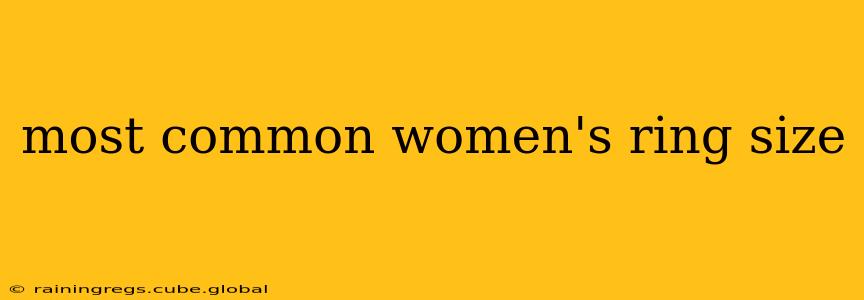Finding the perfect ring is a significant event, whether it's an engagement ring, a wedding band, or a special gift. A crucial first step is knowing the most common women's ring size. While there's no single definitive answer, understanding the average and factors influencing size helps navigate this process successfully. This guide delves into the most frequently asked questions surrounding women's ring sizes, providing valuable insights for both gift-givers and ring-shoppers.
What is the average women's ring size?
The most commonly cited average women's ring size in the United States and many other countries is a size 6. However, this is merely an average; sizes can vary significantly depending on factors discussed below. It's crucial to remember that this average shouldn't be relied upon for gift-giving; always strive for a more precise measurement.
How do I find out my ring size?
Several methods exist for determining your ring size accurately:
-
Professional Measurement: The most accurate method is having a jeweler measure your finger professionally. They use a ring sizer tool for precise measurements, considering finger width and knuckle size.
-
At-Home Ring Sizing Kits: These kits provide tools to measure your finger's circumference at home. While convenient, precision might be slightly less accurate compared to a professional. Ensure to follow instructions diligently.
-
Using Existing Rings: If you have a ring that fits well, you can use it to estimate your size. Many online retailers offer ring size charts that correlate ring inner diameter to ring size. However, this method relies on the accuracy of your existing ring's size.
What factors affect women's ring sizes?
Several factors can influence a woman's ring size, explaining the variation beyond the average:
-
Finger Size: Fingers naturally vary in size; even on the same hand, different fingers can have different sizes. The ring finger is most often used for rings, but variations exist.
-
Hand Size: Generally, individuals with larger hands tend to have larger fingers and therefore larger ring sizes.
-
Age: Finger size can subtly change with age and fluctuations in weight.
-
Time of Day: Your finger size might slightly swell throughout the day due to changes in temperature and fluid retention. It's best to measure your finger in the afternoon or evening when swelling is more likely.
What if I don't know the recipient's ring size?
Not knowing the recipient's ring size is a common challenge, particularly when purchasing an engagement ring. Several strategies can help:
-
Borrow a Ring: Discreetly borrow a ring that the recipient already wears on their ring finger and have it professionally sized.
-
Involve a Friend or Family Member: Enlist the help of someone close to the recipient who might know their ring size or can subtly find out without revealing the surprise.
-
Purchase a Resizable Ring: Some ring designs are resizable, offering flexibility if the initial size proves incorrect. However, this might limit design options.
Can ring size change?
Yes, ring size can change due to several factors including weight fluctuations, age, and even pregnancy. While these changes are often subtle, it's beneficial to consider them, especially for rings worn frequently.
Are there different ring sizing systems?
Yes, different countries and regions may use different ring sizing systems. It's essential to check the sizing system used by the jeweler or retailer to ensure accuracy.
By understanding the average ring size and factors influencing it, choosing the right ring becomes more manageable. Remember, prioritizing accurate measurement is key to a perfect fit and a happy recipient. Always err on the side of caution and consult a professional jeweler for the most accurate measurement.
